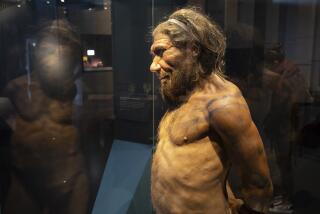BOOK REVIEW : Charting ‘Ascent of the Mind’ : THE ASCENT OF MIND: <i> by William H. Calvin</i> . Bantam Books $19.95, 222 pages
How did the universe begin? And how did we alone, of all the species on Earth, develop the mental power to frame that question?
Author William Calvin has approached both these haunting questions before, most notably in his well-received 1986 book, “The River That Flows Uphill,” whose ambitious--and deceptively offhand--subtitle is “A Journey from the Big Bang to the Big Brain.”
Now, in his latest book, “The Ascent of Mind,” Calvin takes up where he left off at the end of “River”: wondering how the human brain was able to develop so astonishingly in a mere (evolutionarily speaking) 2.5 million years.
“Before the ice ages started 2.5 million years ago,” Calvin writes, “we were upright and even looked pretty human, if seen from a distance. Yet up close, it would have been apparent that behind that large face was an ape-sized brain. Then the ice ages started. Great continental ice sheets formed and then they melted off, dozens of times.
“During all that, we evolved much faster than in the preceding few million years. We now have smaller faces, though with a notable forehead. Seen in side view, however, there is a big difference. That’s because our brains have quadrupled in size over the early model hominid.”
Nothing like this physical transformation happened, the author says, to any other creatures on earth during the same period. And the growth in human brain size was accompanied by an even more spectacular increase in intellectual power. How did we, Calvin asks, learn to use true language, contemplate the past, plan for the future, create art and music, and, philosophically if not always in practice, develop ethical principles? By way of an answer, Calvin sets himself a more specific question. What was the connection linking the past 2.5 million years’ three major developments--the ice ages, human brain growth and prolific tool use?
The author argues against the generally accepted answer: that the frigid weather rewarded tool use, which in turn led to larger brains. He says instead that the ice ages led directly to larger brains, which later facilitated tool making.
As might be expected of a professor of neurobiology, Calvin’s argument is sophisticated. But the author is an unusual academician in that he writes accessibly, even entertainingly, and illuminates his story of the birth of human consciousness with colorful material drawn from sources far from his own field.
Favoring essayist Loren Eiseley with the most direct quotations, he also cites, with familiarity, the work of developmental biologists, geologists, climatologists, linguists, anthropologists, archeologists, primatologists, astronomers, historians, philosophers and even poets.
Despite the intellectual entertainment value of “The Ascent of Mind,” though, Calvin intends his new book to be more than a brain-teaser. It is a warning as well. Humankind is vastly and dangerously overextended, the author says.
As an example, he compares the population of cold, dry Canada (27 million) with cold, wet Europe (700 million, including the European part of the Soviet Union), noting that a climatic “hiccup” could rob Europe of its usual rainfall for a thousand years or more. Precisely that sort of fluctuation has happened, he says, no fewer than 20 times in the past 120,000 years, with the last frigid dry spell descending on Europe only 11,500 years ago. If that happened now, he wonders, where would a half-billion displaced Europeans go?
As a popular science writer, Calvin offers everything a reader looks for. He explains unfamiliar concepts clearly, but not condescendingly. If he occasionally forgets us and theorizes in high gear, he generally sees in Cinemascope and renders the big picture simply and directly.
And he tells memorable anecdotes, mostly drawn from his own eventful life. A hands-on scientist, the author describes how he once recruited a discus thrower from the University of Washington (Calvin’s home campus) to help him figure out how primitive hunters threw a common hand ax.
After flinging the ancient axes around a wet soccer field for an afternoon, he noted that they landed vertically no matter how they were thrown. From that fact he developed a convincing, and apparently original, theory about how early humans used the axes to bring down large animals.
Calvin builds his narrative around a journey he took to Europe, interweaving set-piece lectures and informal reflections on science with descriptive sketches of exotic places along his route. The structuring device works well when the travel notes resonate metaphorically with the scientific ideas, but some of the travel anecdotes seem gratuitous.
Calvin is a bit wide-eyed, though, about the power of science as a panacea. For example, he proposes pouring chemicals on the Atlantic Ocean to prevent the drying-out of Europe, a technique that might raise eyebrows among environmentalists.
But if the reader can overlook such lapses, “The Ascent of Mind” is as delightful as it is thought-provoking.
Next: Jonathan Kirsch reviews “In Mormon Circles” by James Coates (Addison-Wesley) .
More to Read
Sign up for our Book Club newsletter
Get the latest news, events and more from the Los Angeles Times Book Club, and help us get L.A. reading and talking.
You may occasionally receive promotional content from the Los Angeles Times.







